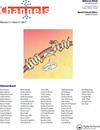电压与配体I: S3节段固有柔韧性的结构基础及其在离子通道激活中的意义
IF 3.2
3区 生物学
Q2 BIOCHEMISTRY & MOLECULAR BIOLOGY
引用次数: 9
摘要
我们系统地预测了S3段的内部灵活性,S3段是电压传感器领域中最具移动性的元件之一。通过分析V-sensor蛋白(包括Hv1、TPC通道和电压感应磷酸酶)的一级氨基酸序列,我们建立了VGIC超家族不同成员的局部柔韧性与激活模式之间的相关性。利用现有的结构信息,我们还对结构方面进行了评估,以了解S3的灵活性在孔的门控过程中所起的作用。我们发现S3的灵活性主要由两个特定区域决定:(1)螺旋n -半部分的短NxxD基序(S3a),以及(2)所谓的桨基序开始的短序列,该片段具有扭结,在某些情况下,将S3分成两个不同的螺旋(S3a和S3b)。发现S3的柔韧性与报告的温度敏感性和机械拉伸之间存在良好的相关性。因此,如果通道对热或膜拉伸表现出高敏感性,则局部S3柔韧性较低。另一方面,S3的高灵活性优先与表现出较差的热和机械敏感性的通道相关。相反,我们没有发现S3柔韧性与电压或配体依赖性之间有任何明显的相关性。总的来说,我们的结果为通道门控及其调制的动力学提供了有价值的见解。本文章由计算机程序翻译,如有差异,请以英文原文为准。
Voltage vs. Ligand I: Structural basis of the intrinsic flexibility of S3 segment and its significance in ion channel activation
ABSTRACT We systematically predict the internal flexibility of the S3 segment, one of the most mobile elements in the voltage-sensor domain. By analyzing the primary amino acid sequences of V-sensor containing proteins, including Hv1, TPC channels and the voltage-sensing phosphatases, we established correlations between the local flexibility and modes of activation for different members of the VGIC superfamily. Taking advantage of the structural information available, we also assessed structural aspects to understand the role played by the flexibility of S3 during the gating of the pore. We found that S3 flexibility is mainly determined by two specific regions: (1) a short NxxD motif in the N-half portion of the helix (S3a), and (2) a short sequence at the beginning of the so-called paddle motif where the segment has a kink that, in some cases, divide S3 into two distinct helices (S3a and S3b). A good correlation between the flexibility of S3 and the reported sensitivity to temperature and mechanical stretch was found. Thus, if the channel exhibits high sensitivity to heat or membrane stretch, local S3 flexibility is low. On the other hand, high flexibility of S3 is preferentially associated to channels showing poor heat and mechanical sensitivities. In contrast, we did not find any apparent correlation between S3 flexibility and voltage or ligand dependence. Overall, our results provide valuable insights into the dynamics of channel-gating and its modulation.
求助全文
通过发布文献求助,成功后即可免费获取论文全文。
去求助
来源期刊

Channels
生物-生化与分子生物学
CiteScore
5.90
自引率
0.00%
发文量
21
审稿时长
6-12 weeks
期刊介绍:
Channels is an open access journal for all aspects of ion channel research. The journal publishes high quality papers that shed new light on ion channel and ion transporter/exchanger function, structure, biophysics, pharmacology, and regulation in health and disease.
Channels welcomes interdisciplinary approaches that address ion channel physiology in areas such as neuroscience, cardiovascular sciences, cancer research, endocrinology, and gastroenterology. Our aim is to foster communication among the ion channel and transporter communities and facilitate the advancement of the field.
 求助内容:
求助内容: 应助结果提醒方式:
应助结果提醒方式:


